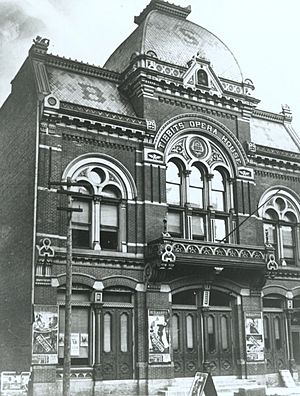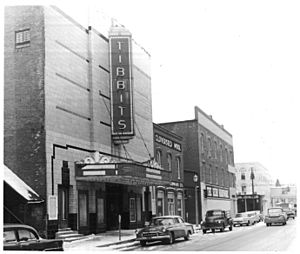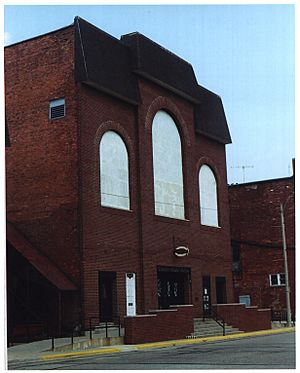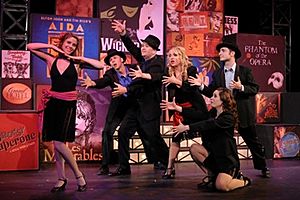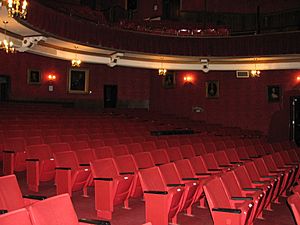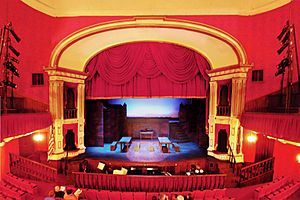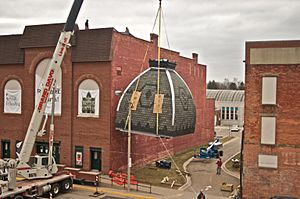Tibbits Opera House facts for kids
Quick facts for kids Tibbits Opera House |
|
|---|---|
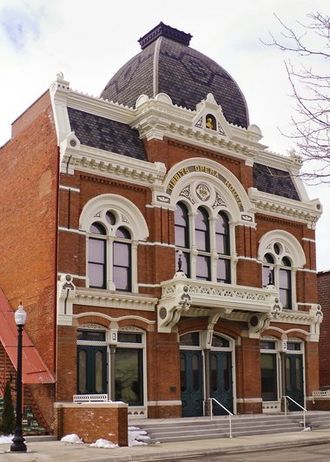
Tibbits Opera House after restoration
|
|
| General information | |
| Architectural style | Second Empire |
|
Tibbits Opera House
|
|
| NRHP reference No. | 100003577 |
| Significant dates | |
| Added to NRHP | March 25, 2019 |
| Location | 14 S. Hanchett St., Coldwater, MI 49036 |
| Coordinates | 41°56′26″N 85°00′15″W / 41.94056°N 85.00411°W |
| Completed | 1882 |
The Tibbits Opera House is a famous old building in Coldwater, Michigan. It's a place where people watch plays, concerts, and other shows. Built in 1882, it is one of the oldest theaters in Michigan. The building was added to the National Register of Historic Places in 2019.
Contents
Building a Special Theatre
Coldwater was a busy town in the 1800s. It was on the main train line between Detroit and Chicago. This meant new ideas and entertainment often came to town. Coldwater was also a popular vacation spot because of its lakes and parks. Many visitors and performers stopped there. Because of this, people in Coldwater became very interested in art and culture.
Barton S. Tibbits, who was the mayor of Coldwater, decided to build a grand opera house. Another local businessman, H.C. Lewis, first suggested the idea. They both planned to put in $8,000. But Lewis changed his mind. Tibbits decided to go ahead alone. He said he would build it even if it hurt his cigar business.
People described Tibbits as a very energetic and generous person. He was always ready to help others. Building the opera house was one of the most expensive projects he ever did. He later said it caused him financial trouble.
Tibbits hired Mortimer Smith, who also designed the Detroit Opera House. The local newspaper, the Coldwater Republican, said the new theatre would be one of the best in the state. The chosen spot was on S. Hanchett Street, close to Tibbits' cigar factory. Construction started in November 1881. The theatre opened almost a year later, on September 21, 1882. The newspaper called it a very safe and strong building.
At the opening, Tibbits said he built the opera house for two reasons. First, he wanted to create something special that everyone in Coldwater would enjoy. Second, he wanted to show that he cared about making the city beautiful. He was proud to offer a place for entertainment that was "unequaled in any city the size of Coldwater."
The Coldwater Republican praised Tibbits' efforts. They said the city needed a good place for entertainment. They were proud of the beautiful building. The first show at Tibbits Opera House was a play called Maid of Arran. It opened on September 21, 1882.
Different Times, Different Shows
The Tibbits Years (1882-1885)
In the 1800s, opera houses were like community centers. They hosted town meetings, local talent, and traveling performers. Even though they were called "opera houses," they didn't just show operas. They were named to sound grand, like the big theaters in Europe.
Performers often traveled in groups, putting on different plays or acts. These groups would move from city to city. By the early 1900s, special theaters for variety shows, called vaudeville theaters, became popular.
After its grand opening, Tibbits Opera House had many busy years. It hosted all sorts of shows. During Tibbits' time, there were 111 plays, mostly comedies. Famous plays by William Shakespeare like Richard III and Romeo and Juliet were also performed. Uncle Tom's Cabin was also very popular, though some local reviewers didn't like it.
But Tibbits hosted more than just plays. It was a great place for public speeches and talks. These talks covered many topics, like how to treat animals kindly, or stories about people who used to break the law. Barton's father, Allen Tibbits, even gave a talk about the first people of North America. Political speeches were also common.
The opera house also had trained dog shows, wrestling matches, and variety shows with acrobatics and juggling. There were also musical groups and shows using a special projector called a stereopticon. Local people shared their talents in shows and poetry readings. The building was used for high school graduations, dances, and costume parties.
Even with all these events, the opera house struggled financially. In 1885, it almost closed down. But the community loved the theatre and worked hard to save it.
The Henning Years (1885-1894)
In 1885, Joseph Henning bought the opera house for $13,000. This was about half of what it cost to build. Henning tried new things to bring in business. He opened a restaurant and a bowling alley in the basement. Later, the saloon became a tearoom run by his wife and daughters.
One surprising manager during this time was Henning's teenage daughter, Huldah. By 1891, she was managing the theatre herself. She often signed her father's name because many performers wouldn't accept a female manager. People said Huldah was probably the youngest and only successful female opera house manager in the country.
Henning tried to bring in better touring shows. But frequent cancellations and money problems still threatened to close Tibbits. People suggested using the building as a town hall or a beer garden. But none of these ideas worked out.
The types of shows became even more varied during Henning's time. There were Irish comedies, dramas, and operas. Comedies started to include more variety acts, focusing on the performers' songs, dances, and acrobatics. Uncle Tom's Cabin shows continued, with special effects like real rain on stage. Some shows even used real horses! This was part of a trend to make shows more realistic.
Lectures also became more common, sometimes sponsored by the YMCA. Topics included problems for working people, life in Russia, military life after the Civil War, and life in Siberia. Famous speaker Robert G. Ingersoll gave a popular talk about Abraham Lincoln. These events made Tibbits a place for both fun and learning.
Political speeches and rallies were also frequent, mostly for Republican causes. Two governors even spoke at Tibbits.
Tibbits also hosted wild and exciting shows. There were boxing matches with famous fighters like John L. Sullivan. There were trained animal acts, mind-reading performances, and even camel rides. One show featured a horse race with real horses on stage! Another show gave away a cow as a prize.
Musical performances were popular too. Groups like the "Boston Symphony Orchestral Club" and the "Michigan University Glee and Banjo Club" performed. Minstrel groups also appeared, often with circus-like acts. Some shows pushed the limits of what was considered proper for the time. One reviewer called a show with "scantily dressed" women "the vilest show that ever appeared in Coldwater."
Other events included art shows, high school graduations, marionette shows, and even a health convention.
The Jackson Years (1894-1920)
Joseph Henning eventually gave the theatre to his daughter Huldah and her husband, John T. Jackson, in 1894. They owned and ran it until 1920. Huldah's sister later said that under John T. Jackson's management, Coldwater saw the very best plays, operas, and music. Jackson was the first manager who truly understood the theatre business. He made the opera house financially successful for the first time.
Jackson also made many improvements to the theatre. He updated the stage machinery, added more space, and made ticket sales easier. He installed electric fans for comfort and a sprinkler system and steel fire curtain for safety. These changes likely helped the theatre last, as many other theaters were destroyed by fire.
Jackson had to raise ticket prices, which upset some local newspapers. But a new newspaper, The Daily Reporter, supported Jackson. This newspaper survived, showing its loyalty to the opera house.
Tibbits Opera House continued to host many types of shows. These included melodramas, comedies, and plays with amazing scenery. Comedies often included elements of variety shows. The opera Faust was popular, known for its special effects. One musical, Wang, even featured an elephant drinking beer on stage! From 1894 to 1904 alone, 376 plays were performed.
Music remained popular, with groups like the "Chicago Marine Band" and the famous "Sousa Band" led by John Philip Sousa. In 1898, there was even an outdoor concert from the Tibbits balcony.
Speeches and lectures continued to be a regular part of the schedule. Topics included humor, economic issues, and freedom. Political speeches were also common, with governors and other important figures speaking.
Variety and vaudeville shows grew in popularity. There were pantomime acts and magic shows. Some shows explored mysterious topics like spiritualism and occult phenomena.
As technology advanced, Tibbits brought new innovations to the stage. Early moving pictures were shown using machines like cinematoscopes. These allowed people to see moving images, even showing soldiers marching during the Spanish–American War. These early films were important steps toward modern cinema.
Barton S. Tibbits, who started it all, lived to see his dream succeed. When he passed away in 1889, his memorial service was held on the very stage he built. The opera house also held memorial services for President McKinley.
The Cinema Years (1919-1963)
In 1919, Dennis and Estella Vanes bought Tibbits and started showing movies. William J. Schulte bought it in 1934 and changed its look to be more like a modern movie theater.
The Modern Era (1963-Present)
By the late 1950s, Tibbits was boarded up and almost torn down. But local people rallied to save it. They raised money and restored the inside to its original Victorian style. The Tibbits Opera Foundation and Arts Council was started in 1963. Today, it runs the building all year as a community arts center.
Tibbits now offers many programs for children and teens. These include plays where kids are the actors, touring shows, and special shows for children.
The theatre also hosts concerts with different touring performers. The Tibbits Art Gallery downstairs shows art by professional artists, local groups, and children. It also has a yearly show for high school students. Tibbits holds an annual benefit auction that helps raise money and is a big social event. Many community groups also use the theatre for their own plays, musicals, concerts, and dance programs.
Throughout the year, Tibbits presents an entertainment series. Famous performers like Jeff Daniels, Melissa Manchester, and John Corbett have appeared. The goal is to bring high-quality arts and well-known entertainers to the community.
Funding for Tibbits Opera House mostly comes from people and companies who become members of the Tibbits Opera Foundation.
Tibbits Summer Theatre
Tibbits has always aimed to present the best theatre. Since 1966, Tibbits Summer Theatre (TST) has brought professional theatre to Southwest Michigan. USA Today even called Tibbits one of "10 great places to see the lights way off Broadway."
Before 1966, another group produced the summer shows. But by 1966, Tibbits decided to produce its own season. Musicals became a main part of the Tibbits season and still are today. Tibbits has produced big-name musicals like Show Boat and South Pacific. It has also introduced audiences to newer shows like Lucky Stiff and I Love You, You're Perfect, Now Change.
Building Design
Original Look
Newspaper articles from 1882 give us a great idea of what the Tibbits Opera House looked like. From old photos and these descriptions, we can imagine how amazing it was when it first opened. It was truly an architectural masterpiece.
The outside of the building had a French "Second Empire" design. It had a tall, slate-covered dome, called a cupola, with a golden eagle statue on top. The very tip of the dome was 76 feet above the street. At the bottom of the cupola, there was a bronze statue of Shakespeare. Below that, the words "Tibbits Opera-House, 1882" were written in gold above a window. The front of the building used iron, red and black bricks, and cut stone. Three large windows let sunlight into the lobby. Below the middle window was an iron balcony with glass globe lanterns.
When you entered, you would find a lobby with two staircases leading to the balcony. There was also a manager's office and a smoking room. Inside the main auditorium, 94 gas lights made of polished brass glowed softly. The stage itself had 174 gas lights. All the lights could be controlled from the stage. A large chandelier in the center, called an "Opal glass reflector," sparkled light everywhere. The floor was covered with soft red carpet. The seats were grand opera chairs, covered in dark red fabric. Many chairs had footrests and racks for hats and umbrellas. Amazingly, the auditorium originally held 1,000 seats! The walls were painted in soft colors like cameo, red, green, and gold. This made the room look bright and airy. The stage was very grand, 34 feet wide and 53 feet long. It had elegant opera boxes on the sides.
The stage had all the newest technology. Scenery and curtains could be moved using ropes and pulleys. The stage also had trapdoors and everything needed for special effects. Speaking tubes and bells connected the stage manager to the box office and other areas. The theatre had a huge collection of high-quality scenic backdrops.
The opera boxes were decorated with red silk curtains. In the center of the arch above the stage, there was a portrait of William Shakespeare. Above that, painted cherubs represented music and drama. More cherubs with garlands of flowers were painted around the main chandelier. The walls were also decorated with flowers and designs.
People said the theatre was as elegant as other grand theaters of its time. It also had excellent sound. The Coldwater Republican said it was impossible to describe its beauty; you had to see it to truly understand.
Bringing it Back to Life
After many years, by the end of the 1950s, Tibbits was going to be torn down. But local supporters worked hard to save it. Many other theaters were destroyed, but Tibbits Opera House was saved thanks to concerned citizens. They restored the inside to its Victorian style. The Tibbits Opera Foundation and Arts Council was started in 1963 and now runs the theatre.
Around the year 2000, the Tibbits Opera Foundation started another big restoration project. They began raising money and planning in 2002. The goal was to bring Tibbits back to its original grandeur. In 2006, they added a handicap accessible entrance and elevator to make the theatre easier for everyone to use. In 2009, a new cupola was lifted onto the theatre. Then, from 2011 to 2013, they restored the outside of the building to its original French "Second Empire" design.


